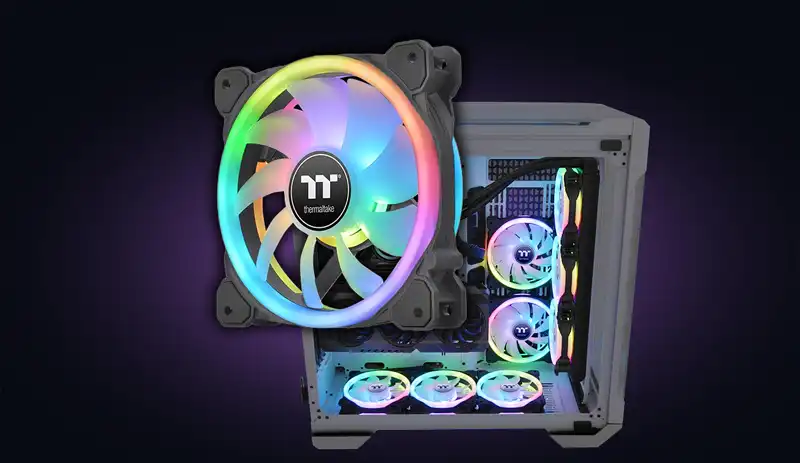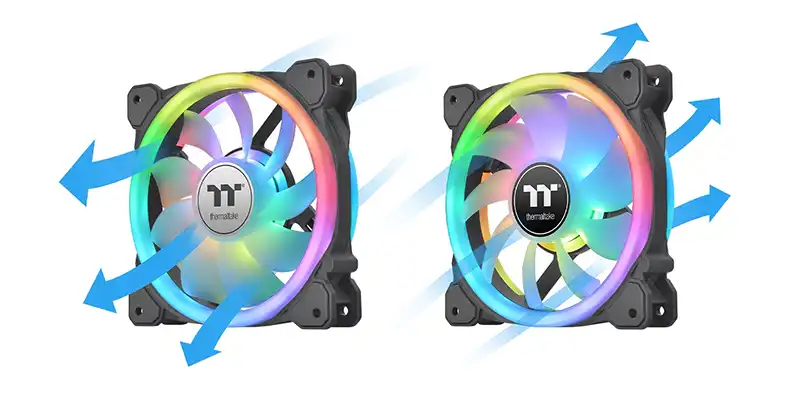You can also be interested in these:
- Corsair AF120 RGB Elite full review
- Corsair iCUE H150i ELITE LCD XT full review
- Arctic Alpine 17 CPU cooling fan review
- Noctua NH-D12L review
We’ve got a fresh series of fans from the Thermaltake brand, The Thermaltake Swafan RGB. Both versions, the 12 and 14 are available with external connectors, while the EX series has integrated connectors.

These fans come equipped with interchangeable blade systems, allowing them to generate airflow on both sides without requiring a change in the fan’s orientation. They feature a premium design and construction, complete with the Riing’s lighting system, which includes three addressable RGB LED-to-LED rings and a controller. At first glance, they seem to be among the best options in terms of quality and aesthetics. But, will they live up to our expectations?
Design and construction with interchangeable blades
We’re now going to delve into the Thermaltake Swafan RGB fans’ analysis, focusing on their design, which is the same for both the 140mm and 120mm versions. They start with a similar base to that of the Riing Trio, consisting of a plastic chassis where the double-sided and interior lighting system takes center stage with rings.
The outer chassis remains in a black ABS plastic format with exposed corners and no square frame to integrate everything. This approach allows for better appreciation of the lighting system while ensuring good robustness. However, in the EX12 and EX14 versions, we do have a complete frame that integrates the connection headers. Each of these corners has a double-sided rubber cover to eliminate as much noise as possible.

Moving to the back, we’ll find the motor and blade attachment system that uses four black sticks. These sticks integrate a small inner ring of the same color, which holds the two outer translucent plastic rings responsible for lighting up a total of 24 ARGB LEDs – 12 on each side.
The most distinctive feature of the Thermaltake Swafan 12 RGB and 14 will undoubtedly be the blades, as they come with a rotation system that allows them to be interchangeable. The system starts with nine helically designed translucent plastic blades that are quite robust. The rotation axis is integrated into the central drum, which is pressed onto the motor and sealed with an integrated rubber cover on the bottom to prevent lubricant leakage.
The drum integrates the electromagnets that generate the rotation, and even a double ring that allows for heat dissipation. Moving to the motor area, we’ll basically find a PCB that integrates the circuit of 4 coils and, therefore, 4 poles that will power the fan. The translucent ring around it has 6 LEDs for the interior lighting ring.
To remove the fan blades, all we need to do is apply uniform pressure on both ends with at least two fingers until we separate the bearing. To install them back, we must exert uniform pressure inwards. A syringe with 0.5 ml of high-performance lubricant is included for bearing maintenance, and the amount can last a long time since only a minimal amount is needed.
Lighting system, controller, and software
Regarding the lighting system, both the Thermaltake Swafan 12 RGB and the Thermaltake Swafan 14 RGB will have the same components. Essentially, they will consist of two double-sided outer rings, each with 12 LEDs, and an inner ring with an additional 6 LEDs that light up the blades.
An essential component for these fans is the Thermaltake 4th generation microcontroller that comes included. Firstly, because each fan has a unified 9-pin interface that is only compatible with the brand’s controllers. Secondly, the microcontroller provides separate ARGB LED-to-LED and PWM control for each unit.
To achieve this, the controller has 5 fan inputs, a 4-pin SATA power input, a Micro USB for front plate connection, and a DSC header to synchronize with other controllers in series. At the back, there are 4 small switches that allow us to assign a number to the controller if it is connected in series with others. This way, we can generate a total of 16 numbers (like binary code), and manage them from the software.
Once the system is assembled, the next step is to install the Thermaltake TT RGB Plus 2.0 software to manage these Thermaltake Swafan 12 RGB or any other product from the brand’s ecosystem. The first step is to configure the active inputs on the controller with the fans in question, and there is a long list of Thermaltake products to choose from.
There are two crucial sections in this case:
- The first one is the Swafan RGB section, where we can manage each connected unit (in our case 4), regardless of whether they are 120mm or 140mm as they have the same number of LEDs. Each fan is represented graphically with three rings, separate LEDs, and real-time RGB transitions. We have complete control over customization with available animations, colors, and transitions.
- The fan speed section allows separate PWM control of each fan, again with a graphical representation of the model in question, its real-time RPM, and even the possibility of assigning a name. The fans support two predefined profiles in performance and silent modes with adaptable graphics, as well as the PWM mode where we can adjust a specific rotation speed.
This system offers a wide range of possibilities, and while there is no layer management like Corsair or Razer, with some effort, the possibilities are vast. Also, we do not have an RPM curve as such, but the potentiometers will help in adopting almost any type of profiles.
Final thoughts on the Thermaltake Swafan RGB
The Thermaltake Swafan RGB fans are possibly the most comprehensive fans that Thermaltake has launched, as they offer an excellent user experience both aesthetically and technically. Their balanced static pressure and flow configuration make them an excellent choice for both cases and radiators.

In terms of performance, the high-quality construction of these fans is notable, along with their interchangeable blades. Although the feature may seem geeky, it is quite useful since with the same installation position, we can have push or pull flow with almost the same effectiveness. The system is simple, but we would not recommend removing and replacing the blades regularly to avoid bearing wear.
If aesthetics are the priority, the fans have a Riing Trio-style design with a triple RGB ring and a total of 30 individually addressable LEDs. The included controller with 5 outputs and the control software will give us not only RGB effects but also PWM control.
More stories like this
- Corsair AF120 RGB Elite full review
- Corsair iCUE H150i ELITE LCD XT full review
- Arctic Alpine 17 CPU cooling fan review
- Noctua NH-D12L review
- Arctic Freezer A35 A-RGB review for AMD AM4 socket
- Be Quiet! Light Wings, the most silent cooling fan